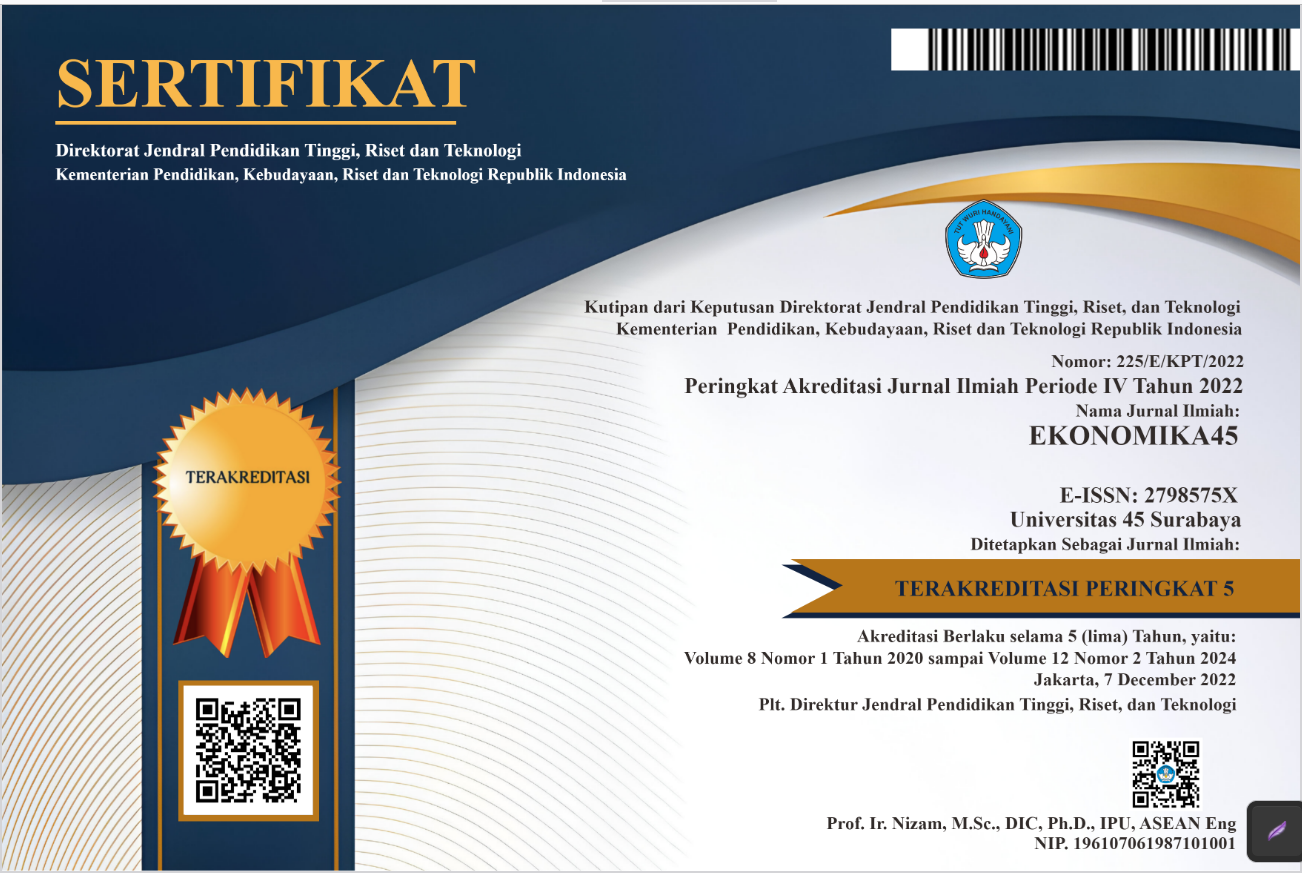Evaluasi Program Izin Mendirikan Bangunan Terhadap Kawasan Kumuh Berdasarkan Tingkat Komunitas Dan Fasilitas Di Indonesia
DOI:
https://doi.org/10.30640/ekonomika45.v10i1.1015Abstract
The building permit (IMB) policy implemented by the government aims to reduce the incompatibility of the built area with the existing spatial plan. This policy was implemented by the government through Government Regulation Number 36 of 2005 which contained the granting of permits by the Regional Government to building owners to construct buildings. However, this policy has changed its name to Building Agreement (PBG) in 2021 through Government Regulation Number 16 of 2021. In this case, the IMB seeks to reduce the discrepancy in the area of land that is used illegally which can result in the emergence of slum settlements. This study aims to see how much change has been caused by the IMB program to reduce slum area in Indonesia by using the Difference in Difference method. This method is generally used to measure how big the impact of a policy, project, activity carried out by the government. The measurement and evaluation of these impacts aims to assess how effective a program or policy is and is based on suitability with the desired goals.
The data in this study were sourced from secondary data, namely the Indonesian Family Life Survey 4 and 5 which covered 13 provinces. The results of the study conclude that the IMB program has a negative effect on the existence of slums in the model test without a covariate with a significant level of 5% or 0.018 and in the model test with a covariate with a significant level of 5% or 0.034.
References
Date, S. (2022, June 20). A Guide to Using the Difference-In-Differences Regression Model. https://towardsdatascience.com/a-guide-to-using-the-difference-in-differences-regression-model-87cd2fb3224a.
Hadinagoro, E. R. G., & Qomarun. (2021). Pola perkembangan slump dan squatters di desa banyudono. Seminar Ilmiah Arsitektur II, 8686, 628–633.
Murtiono, H., Sari, S., & Pandelaki, E. E. (2020). Peran Hunian Vertikal Sebagai Solusi Terhadap Kawasan Kumuh Di Kota Batam Kepulauan Riau. Jurnal Arsitektur ARCADE, 4(1), 47. https://doi.org/10.31848/arcade.v4i1.326
Pemerintah Indonesia. (2021). Peraturan Pemerintah No. 16 Tahun 2021 Tentang Peraturan Pelaksanaan Undang-Undang No. 28 Tahun 2002 Tentang Bangunan Gedung. Jakarta.
Peraturan Pemerintah. (2016). Peraturan Menteri Pekerjaan Umum dan Perumahan Rakyat No. 2 Tahun 2016 tentang Peningkatan Kualitas Terhadap Perumahan Kumuh dan Permukiman Kumuh. Jakarta.
Prayojana, T. W., Mardhatil, Fazri, A. N., & Saputra, B. (2020). Dampak Urbanisasi Terhadap Pemukiman Kumuh (Slum Area). Jurnal Kependudukan dan Pembangunan Lingkungan. (2): 13-20.
Peraturan Menteri Pekerjaan Umum dan Perumahan Rakyat. (2016). 02(M), 11–40.
Prayojana, T. W., Fazri, A. N., & Saputra, B. (2020). Dampak Urbanisasi Terhadap Pemukiman Kumuh (Slum Area). Jurnal Kependudukan Dan Pembangunan Lingkungan, 2(1), 13–22. http://jkpl.ppj.unp.ac.id/index.php/JKPL/article/view/12/7
Riogilang, H. (2016). Identifikasi dan Pendampingan Untuk Mengatasi masalah Sanitasi Pada Pemukiman Kumuh di Kampung Sanger, Sario Manado. Jurnal LPPM Bidang Sains dan Teknologi. 3(2): 54-62.
Sari, A. P. (2019). Pengaruh Remitansi Terhadap Perbedaan Kesejahteraan Rumah Tangga Di Indonesia Dengan Metode Propensity Score Matching. Jurnal Ekonomi Pembangunan. 8(2): 171-194.
Setiono, I. (2013). Perencanaan Daya Listrik Pada Kawasan Permukiman dengan Interpretasi Foto Udara. Prosiding SNST.
Strauss, J., Witoelar, F., dan Sikoki, B. (2016). The Fifth Wave of the Indonesia Family Life Survey: Overview and Field Report. RAND Working Paper: Labor & Population. WR-1143/1-NIA/NICHD.
Sulestianson, E. (2014). Penanganan Permukiman Kumuh Dengan Pendekatan Karakteristik dan Faktor Penyebab Kekumuhan ( Studi Kasus : Permukiman Kumuh di Kelurahan Tamansari dan Kelurahan Braga ). Jurnal Perencanaan Wilayah Dan Kota B SAPPK V3N2, 261–270. http://sappk.itb.ac.id/jpwk2/wp-content/uploads/2014/08/Erick-Sulestianson.pdf
Wahyuningtyas, I., & Purnomo, D. N. H. (2020). NGAGELREJO KECAMATAN WONOKROMO KOTA SURABAYA Ika Wahyuningtyas Abstrak. Swara Bhumi, 2(1), 1–8.
Wijayanti, R., Sutandi, A., & Pravitasari, A. E. (2020). Identifikasi Spasial Faktor-Faktor yang Mempengaruhi Permukiman Kumuh Di Kota Bekasi. Jurnal Tata Loka, 22, 573-585.
Yustiani, R., Prasetyanti, R., Rosidanti, H. (2021). Penataan Permukiman Kumuh Terintegrasi di Kota Semarang. The Indonesian Journal of Public Administration. 7(1): 58-61.









